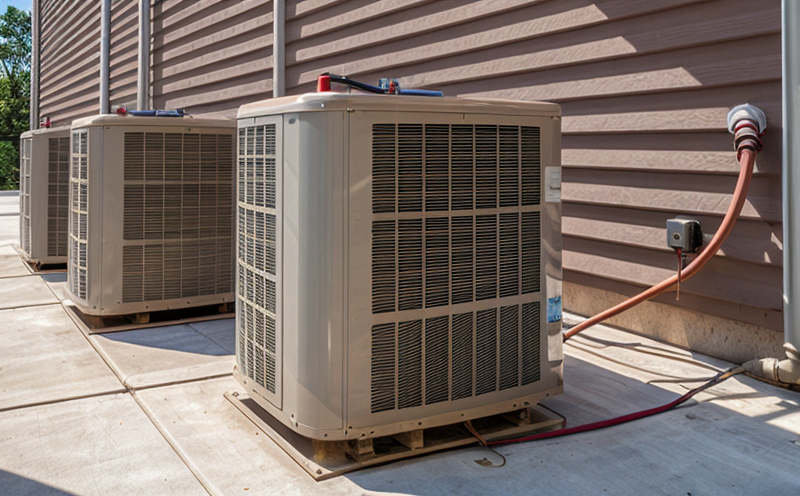EN 15241 Calculation Methods for HVAC Systems
The European Standard EN 15241 establishes calculation methods for determining the heating, ventilation and air conditioning (HVAC) system's cooling capacity in accordance with ISO 7730. This standard is essential for ensuring that HVAC systems meet the required performance levels set by regulatory bodies like the European Committee for Standardization (CEN).
The primary objective of EN 15241 is to provide a methodology for calculating the cooling capacity based on specific parameters such as room dimensions, occupancy rates, and desired comfort conditions. The standard emphasizes the importance of accurate calculations in maintaining occupant comfort while ensuring energy efficiency.
For HVAC system designers and installers, adhering to EN 15241 is crucial for meeting regulatory requirements and achieving optimal performance. By using this method, they can ensure that the cooling capacity matches the actual demand accurately, thereby avoiding over-sizing or under-sizing of the HVAC system.
The calculation methods outlined in EN 15241 are based on empirical data and scientific principles. The standard specifies a series of steps to follow when calculating the cooling capacity, including:
- Identifying the room dimensions
- Determining the expected occupancy levels
- Evaluating the desired temperature and humidity conditions
- Calculating the sensible heat gain and latent heat gain for the space
- Applying the calculated values to determine the required cooling capacity
The standard also provides guidance on how to account for various factors that can influence the cooling capacity, such as window size, insulation quality, and external conditions. By considering these factors, designers and installers can create HVAC systems tailored to meet specific needs.
EN 15241 is widely used in the building and infrastructure testing sector, particularly in projects involving large commercial buildings or public facilities where comfort and energy efficiency are critical considerations. The standard ensures that HVAC systems are designed to provide a comfortable environment while minimizing operational costs.
| Application | Description |
|---|---|
| Data Centers | Ensuring optimal cooling in data centers is crucial for maintaining equipment performance and preventing overheating. EN 15241 helps designers calculate the necessary cooling capacity to meet these requirements. |
| Hospitals | In hospitals, it's essential to maintain a stable temperature and humidity environment for patient comfort and safety. The standard ensures that HVAC systems are designed accordingly. |
| Offices | Office spaces require controlled environments to enhance productivity and occupant well-being. EN 15241 helps in achieving the right cooling capacity by considering occupancy rates and desired conditions. |
In summary, EN 15241 is a vital tool for HVAC system designers and installers, providing a robust methodology for calculating cooling capacities. This ensures that systems are tailored to meet specific performance criteria, thereby enhancing comfort and energy efficiency.
Applied Standards
The EN 15241 calculation methods are aligned with several other international standards, including ISO 7730:2018, which specifies the method for calculating the required cooling capacity of HVAC systems. The standard also references EN 16798-1, which provides guidelines for energy performance of buildings related to heating and cooling.
By adhering to these standards, designers can ensure that their HVAC systems meet not only local regulations but also international best practices. This consistency in methodology helps maintain high-quality installations across different regions.
The integration of EN 15241 with other standards like ISO 7730 and EN 16798-1 ensures a comprehensive approach to HVAC system design, taking into account both cooling capacity and overall energy efficiency. This holistic view is crucial for meeting the diverse needs of modern buildings.
Furthermore, by following these standards, designers can ensure that their systems are optimized for comfort while also contributing positively to sustainability goals. The use of EN 15241 aligns with broader efforts towards sustainable building practices and energy-efficient design.
Industry Applications
- Data Centers: Ensuring optimal cooling is crucial for maintaining equipment performance and preventing overheating.
- Hospitals: Maintaining a stable temperature and humidity environment ensures patient comfort and safety.
- Offices: Controlled environments enhance productivity and occupant well-being by meeting specific thermal conditions.
In data centers, the standard is used to calculate the necessary cooling capacity to meet performance criteria. In hospitals, it helps in maintaining a stable temperature and humidity environment for patient comfort and safety. For offices, it ensures that HVAC systems are designed to provide a comfortable environment while minimizing operational costs.
The standard's application extends beyond these sectors, influencing various aspects of building design and operation. It plays a critical role in ensuring that HVAC systems operate efficiently, contributing to both energy savings and environmental sustainability.
Why Choose This Test
Selecting the appropriate test method is crucial for achieving accurate results when calculating cooling capacities according to EN 15241. The choice of methodology depends on several factors, including project size, complexity, and specific requirements.
Firstly, it is essential to choose a qualified testing facility that has experience in performing EN 15241 calculations. This ensures that the process adheres strictly to international standards and provides reliable results. Secondly, selecting the right equipment is vital for accurate measurements during the testing procedure. High-precision instruments are necessary to capture even slight variations in temperature and humidity.
Thirdly, proper specimen preparation is crucial for obtaining valid test data. This includes cleaning the system thoroughly before testing, ensuring that all components are functioning correctly, and calibrating the instruments accurately. Finally, experienced personnel who understand both the theoretical aspects of EN 15241 and practical application should conduct the tests.
By following these best practices, laboratories can ensure high-quality results that meet or exceed industry expectations. This approach not only enhances credibility but also fosters trust among clients and stakeholders.





